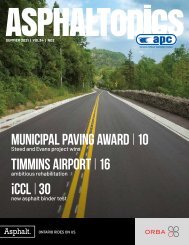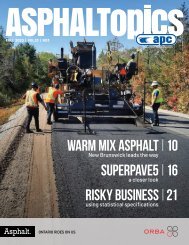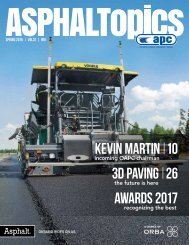ASPHALTopics | Summer 2014 | VOL 27 | NO3
Create successful ePaper yourself
Turn your PDF publications into a flip-book with our unique Google optimized e-Paper software.
y Lisa Fattori<br />
in<br />
April <strong>2014</strong>, OHMPA published Ontario draft contract language for the new Multiple Stress<br />
Creep Recovery (MSCR) graded asphalt cement. The material specification replaces the Superpave<br />
Performance Graded (PG) asphalt binder specification and has been identified as MGAC (MSCR<br />
Graded Asphalt Cement) to avoid confusion. The MSCR procedure improves upon previous testing<br />
methods to provide information about both the performance and formulation of the asphalt binder<br />
through a single test. For heavy traffic areas that require elastomeric polymers in the binder,<br />
the test provides a more accurate assessment of how the asphalt cement will perform.<br />
“We’re always looking for improved tests for both<br />
high and low temperatures, and the existing test didn’t<br />
capture all of the characteristics of modified systems,”<br />
says John D’Angelo PhD., CEO of D’Angelo Consulting<br />
LLC in Washington D.C. “This test is an improvement<br />
because it looks at both modified and unmodified binders.<br />
The previous test used the same equipment, but just<br />
looked at low stress levels – small loading and movement<br />
– and didn’t capture how the AC would react under high<br />
traffic or stress levels. This test gives us a lot more detail;<br />
performance characteristics under high temperatures<br />
and if elastomers have been added to the mix.”<br />
While working at U.S. Department of Transportation’s<br />
Federal Highway Administration (FHWA), D’Angelo was<br />
part of the research team that developed the MSCR<br />
specification. The research project began in 1999,<br />
with finalized test results submitted to the American<br />
Association of State Highway and Transportation<br />
Officials (AASHTO) in 2008. AASHTO published the<br />
MSCR test procedure as a provisional specification,<br />
and conducted trials for another six years. Since 2009,<br />
the MSCR test has been available, with a number<br />
of jurisdictions developing their own methods of<br />
implementing the specifications.<br />
FALL <strong>2014</strong> 29


















